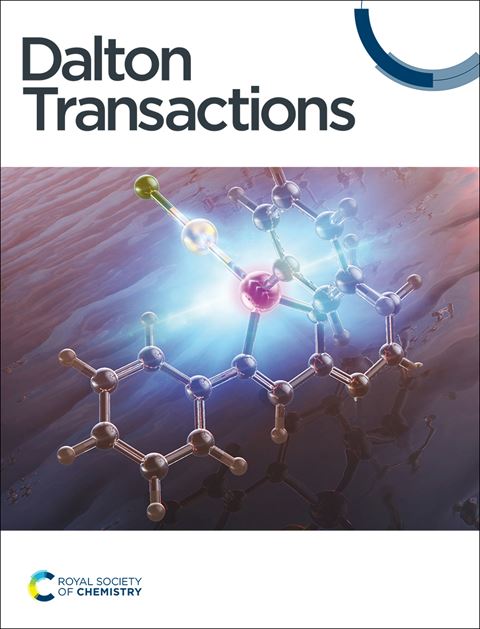二取代咪唑并[1,5-a]吡啶和咪唑吡啶的钯(II)和铂(II)配合物:配位化学、多功能催化、生物物理研究
IF 3.5
3区 化学
Q2 CHEMISTRY, INORGANIC & NUCLEAR
引用次数: 0
摘要
合成了一些含咪唑[1,5-a]吡啶和咪唑基吡啶的钳形单核和多核Pd(II)和Pt(II)配合物,并用多种光谱方法对其进行了表征。用单晶x射线衍射法测定了所有配合物的分子结构,发现在所有配合物中,二价钯和铂的周围都有一个扭曲的方形平面几何结构。Pd(II)配合物在Suzuki-Miyaura交叉偶联反应、转移加氢反应、炔均偶联反应等反应中表现出较高的催化活性。理论研究结果与所有催化剂的实验数据吻合较好。通过改变共配体、配体的结合方式和金属中心数,可以观察到催化活性的显著变化。在最优条件下,仅以0.1 mol%的四核Pd(II)配合物(5)为催化剂,即可实现铃木交叉偶联和转移加氢反应,官能团可能性大。并用质谱法对Suzuki偶联反应的中间体进行了检测。在所研究的配合物中,四核钯配合物表现出较高的催化活性。进一步的Pd(II)配合物在苯乙炔的均偶联模型反应中进行了测试,并以优异的收率生产了二苯丁二炔。利用电子能谱法研究了所有配合物与小牛胸腺DNA (CT-DNA)和牛血清白蛋白(BSA)的相互作用。吸收研究表明,这些配合物与DNA有轻微的凹槽结合,而所有配合物都通过荧光强度猝灭取代EB-DNA中的溴化乙啶(EB)而观察到插入结合。通过发射、同步荧光和稳态荧光各向异性测量证实,配合物对牛血清白蛋白具有较高的结合亲和力。此外,计算了Suzuki偶联反应得到的两种生物活性化合物(3s和3t)的药代动力学性质,并将其与人LTA4H酶对接,以评价其作为白三烯A4水解酶(LTA4H)抑制剂的活性。本文章由计算机程序翻译,如有差异,请以英文原文为准。
Palladium(II) and Platinum(II) Complexes of Disubstituted Imidazo[1,5-a]Pyridine and Imidazolylpyridine: Coordination Chemistry, Versatile Catalysis, Biophysical Study
Some pincer type mono- and poly-nuclear Pd(II) and Pt(II) complexes bearing imidazo[1,5-a]pyridine and imidazolylpyridine moiety were synthesized and characterized by using several spectroscopic methods. Determination of molecular structures of all complexes by single crystal X-ray diffraction studies revealed a distorted square planar geometry around the bivalent palladium and platinum in all complexes. These Pd(II) complexes have been observed to display high catalytic activity in various reaction such as Suzuki-Miyaura cross-coupling reaction, transfer hydrogenation reaction, and alkyne homocoupling. The theoretical study was also well matched with experimental data of all catalysts. Substantial deviations in the catalytic activity were observed by changing the co-ligand, binding mode of the ligand and the number of metal centre. Under optimal conditions, Suzuki cross-coupling and the transfer hydrogenation reaction were accomplished proficiently with wide functional group possibility by taking only 0.1 mol% of tetranuclear Pd(II) complex (5) as catalyst. Intermediates in Suzuki coupling reaction were also detected by using mass spectroscopy. Among all studied complexes, the tetra nuclear palladium complex exhibited high catalytic activity. Further Pd(II) complexes were tested in a model reaction of homocoupling of phenylacetylene and produce diphenylbutadiyne in excellent yield. Also, interaction study of all the complexes with calf thymus DNA (CT-DNA) and bovine serum albumin (BSA) were investigated using electronic spectroscopy Absorption study showed minor groove binding of DNA with these complexes while intercalative binding was observed by all complexes through displacement of ethidium bromide (EB) in EB-DNA by quenching of fluorescence intensity. The complexes were also displayed high binding affinity toward BSA confirmed by emission, synchronous fluorescence, and steady state fluorescence anisotropy measurement. Moreover, the pharmacokinetic properties of two bioactive compounds (3s and 3t) obtained from Suzuki coupling reaction were calculated and to evaluate their activity as leukotriene A4 hydrolase (LTA4H) inhibitor, these molecules were docked with human LTA4H enzyme.
求助全文
通过发布文献求助,成功后即可免费获取论文全文。
去求助
来源期刊

Dalton Transactions
化学-无机化学与核化学
CiteScore
6.60
自引率
7.50%
发文量
1832
审稿时长
1.5 months
期刊介绍:
Dalton Transactions is a journal for all areas of inorganic chemistry, which encompasses the organometallic, bioinorganic and materials chemistry of the elements, with applications including synthesis, catalysis, energy conversion/storage, electrical devices and medicine. Dalton Transactions welcomes high-quality, original submissions in all of these areas and more, where the advancement of knowledge in inorganic chemistry is significant.
 求助内容:
求助内容: 应助结果提醒方式:
应助结果提醒方式:


